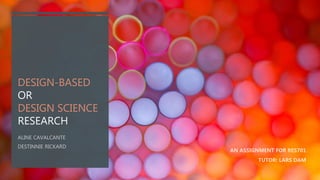Design science presentation By Aline Cavalcante and Destinnie Rickard
- 2. WHAT IS DESIGN SCIENCE RESEARCH? DESIGN SCIENCE RESEARCH IT IS AN APPROACH TO RESEARCH THAT INVOLVES COLLECTING INFORMATION ABOUT A PROBLEM AND TRYING TO FIND A SOLUTION TO IT.
- 3. DESIGN SCIENCE RESEARCH PROCESS KNOWLEDGE BASE Simplified view based on VASHNAVI & KUESHCHLER, 2004. AWARENESS PROPOSAL ŌĆó Industry ŌĆó Reference area ŌĆó Peolple REQUISITES PROVIDED SUGGESTION PROTOTYPE DEVELOPMENT BASED ON REQUISITES DEVELOPMENT ARTIFACT IMPLEMENTATIO N OF TENTATIVE DESIGN EVALUATION PERFORMANCE MEASURES DOES IT WORK WELL WHEN TESTED? CONCLUSION RESULTS SOLUTION CREATED FOR THE PROBLEM + OPERATIONAL AND DESIGN PRINCIPLES
- 4. WHAT IS IT GOOD FOR? DESIGN SCIENCE RESEARCH ŌĆó Software development ŌĆó Systems Design and Development ŌĆó Design creations Any INNOVATIVE project that needs testing while being developed!
- 5. HOW CAN I USE IT IN I.T. RESEARCH? DESIGN SCIENCE RESEARCH ŌĆó IT WAS FIRST USED FOR IT PURPOSES ON INFORMATION SYSTEMS. ŌĆó IT CAN BE USED FOR SOFTWARE AND SYSTEMS DEVELOPMENT ŌĆó IT INNOVATION
- 6. WHAT ARE THE STRENGTHS OF DSR? DESIGN SCIENCE RESEARCH ŌĆó THE ITERATIVE NATURE OF THE DESIGN SCIENCE RESEARCH HELPS MEETING REQUIREMENTS ŌĆó DSR COLLABORATES TO THE KNOWLEDGE BASE CONSTANTLY
- 7. WHAT ARE THE WEAKNESSES OF DSR? DESIGN SCIENCE RESEARCH ŌĆó IT HAS INNOVATION AS A CONSTRAINT ŌĆó IT IS TIME CONSUMING ŌĆó CANNOT BE USED TO ALL TYPES OF PROBLEMS ŌĆó IT MIGHT DRAW FROM MANY DIFFERENT DISCIPLINES, THUS NEEDS IMPROVED COMMUNICATION
- 8. Flow diagram describing the reconstruction process based on the interaction between historical sources and 3D data (Guidi, Russo, & Angheleddu, 2013, p. 104) ŌĆ£The methodology proposed in this paper in based on an integrated approach for creating a 3D digital reconstruction of an archaeological site, using extensively the 3D documentation of the site in its current state, followed by an iterative interaction between archaeologists and digital modelers, leading to a progressive refinement of the reconstructive hypotheses. ŌĆ” This refinement loop on the reconstructive choices is iterated until the result become convincing by both points of view, integrating in the best way all the available sourcesŌĆØ. Problem: Methodology for data management in Architectural Reconstruction and 3D modeling
- 9. (Guidi, Russo, & Angheleddu, 2013)
- 10. REFERENCES DESIGN SCIENCE RESEARCH Guidi, G., Russo, M., & Angheleddu, D. (2013). DIGITAL RECONSTRUCTION OF AN ARCHAEOLOGICAL SITE BASED ON THE INTEGRATION OF 3D DATA AND HISTORICAL SOURCES. ISPRS - International Archives of the Photogrammetry, Remote Sensing and Spatial Information Sciences, XL-5-W1, 99ŌĆō105. https://doi.org/10.5194/isprsarchives-XL-5-W1-99-2013 Helms, R., Giovacchini, E., Teigland, R., Kohler, T. (2010). A Design Research Approach to Developing User Innovation Workshops in Second Life. Journal of Virtual Worlds Research, III. https://doi.org/10.4101/jvwr.v3i1.819 Papalambros, P. Y. (2015). Design Science: Why, What and How. Design Science, 1. https://doi.org/10.1017/dsj.2015.1 MC: Design: Alan Hevner - Is Design Science the Future of Innovation? (2015). Retrieved from https://www.youtube.com/watch?v=llsXxtyiiQo










